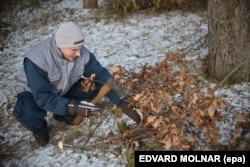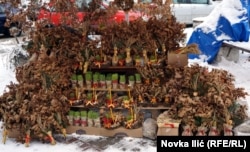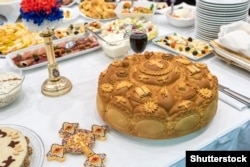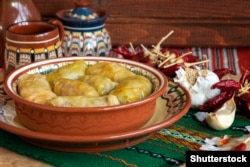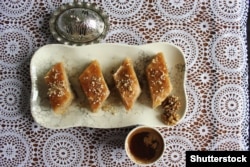As part of an occasional series on how the end-of-year holidays are celebrated in our broadcast area, we asked correspondents from RFE/RL’s Balkan Service to tell us about how Christmas is celebrated in their respective countries, including the typical traditions they observe at this time of year and, of course, the special kinds of food they eat.
Serbia, Montenegro, And North Macedonia
As Orthodox believers, most Serbians, Montenegrins, and Macedonians celebrate Christmas on January 7, sharing many of the same distinctive regional customs.
Given that they have usually pushed the boat out the previous week to celebrate New Year, when gifts are traditionally exchanged, Christmas is a quieter, more family oriented affair.
It’s customary for people to spend Christmas Eve and Christmas Day at home with their nearest and dearest, before venturing out on the third day to deliver season’s greetings to their friends and relatives.
It’s still commonplace on this day for people to abandon traditional forms of address when they meet each other. Instead of the usual greetings, they say, “Christ is born!” when they see someone, with the other person saying, “Truly he is born!” in response.
The celebrations start on Christmas Eve (January 6), which marks the last day of the traditional Orthodox fast. Consequently, although a copious meal is prepared, it usually has no meat, instead comprising roast fish, beans, potatoes, bread, salad, and compote, as well as dried and fresh fruit. Red wine is usually the tipple of choice at the Balkan Christmas table.
Christmas Eve is known as Badnji Dan in Serbian and Montenegrin and simply Badnik in Macedonian. It derives its name from badnjak, a central feature of the Orthodox Christmas tradition in the south Slavic region. Similar to the yuletide log in other countries, badnjak likely has pre-Christian origins and may have been used to symbolize the return of the sun after the winter solstice.
In many parts of the Balkans, the tradition involves the male head of the household chopping branches off an oak tree and bringing them home on the morning of Christmas Eve. The branches are brought into the house as the Christmas Eve feast starts and set alight in the hearth, where their flames are meant to keep burning throughout Christmas Day.
Although this tradition is still widespread in the countryside, many city dwellers nowadays simply buy the branches at Christmas markets and use them to decorate their festive table, as their centrally heated apartments have no fireplaces.
Nonetheless, since the 1990s it has become increasingly popular for public celebrations of badjnak in towns and cities, with the branches often being burned in church yards accompanied by religious songs and recitals, as well as food and drink for parishioners.
In Belgrade, for example, the annual burning of the badnjak in front of St. Sava’s cathedral has become a major seasonal event for many of the city’s inhabitants.
It’s also customary in a lot of places for people to put straw under the tablecloth on Christmas Eve, a reference to the stable setting of Christ’s nativity. Sometimes, the straw is strewn with sweets and small gifts for the children of the house.
On Christmas Day itself, the main feast begins at lunchtime, usually after the Christian faithful have attended morning services. On Christmas morning, the lady of the house traditionally makes “cesnica,” a special type of seasonal bread that is usually made according to a recipe that has been handed down from generation to generation in each family. Consequently, ingredients tend to vary from household to household, but it is habitually made using water, fat, and flour without yeast.
It’s common for the cesnica to be the centerpiece of the table on Christmas Day. Each member of the household has to get a slice before the festive lunch begins. A coin wrapped in baking paper or foil is added to the dough mix and the family member who finds it in their slice can expect prosperity and good fortune in the coming year.
Given that the Christmas lunch is supposed to mark the end of the seasonal fast, there is an abundance of meat dishes on offer, with most families eating “pecenica,” or roast pork and potatoes. Other delicacies that often grace the festive table include “sarma” (stuffed cabbage leaves), regional varieties of soup, and, of course, the nut pastry baklava as a sweet.
How To Make Sarma
Ingredients
1.5 kilograms of pickled cabbage
1 kilogram of minced pork
300-400 grams of rice
100 grams of sliced pancetta or cured bacon
1 large onion
3-4 cloves of garlic crushed
One teaspoon each of salt, mixed herbs, ground paprika, and black pepper
1 beaten egg
Method
- Peel the leaves off a large head of pickled cabbage, rinse well, and blanch in boiling water for a couple of minutes before leaving to cool.
- Finely chop and dice the onion and saute with the crushed garlic in a little vegetable oil. After 5 minutes, add the minced meat, and then mix in the salt, mixed herbs, ground paprika, and black pepper 15 minutes later.
- Rinse the rice and stir it into the mix with the egg. This will be used as stuffing for the sarma.
- Put the stuffing on the sauerkraut leaves and fold into a roll, tucking its ends into the meat to close it completely. Don’t wrap too tightly as some room will be needed for the rice to expand during cooking.
- Cover the bottom of a baking dish with pickled cabbage leaves. Place the stuffed leaves tightly to cover the bottom of the dish completely.
- Push slices of smoked pancetta in between the rolls and cover with hot water (or vegetable/meat stock, if preferred).
- Cover the baking dish and bake at a moderate heat (180 degrees Celsius) for approximately 2 hours. Then take the sarma out of the oven, remove the lid, and put it back to bake for another 15 minutes before serving.
How To Make Baklava With Walnuts
Ingredients
4 cups (468 grams) of finely chopped walnuts
1/4 cup (50 grams) sugar
1 tablespoon of ground cinnamon
1 cup (225 grams) of butter, melted
1 pack (450 grams) of frozen phyllo dough, thawed
For the syrup:
1 cup (200 grams) of sugar
1/2 cup (118 ml) of water
1/4 cup (59 ml) of honey
1 teaspoon of lemon juice
1 teaspoon of vanilla extract
Method
- In a small bowl, combine the walnuts, sugar, and cinnamon before setting aside.
- Grease a 30-centimeter x 9-centimeter baking dish with some of the melted butter.
- Unroll the phyllo dough sheets and place one sheet of phyllo in the baking dish and brush with butter. Top with a second sheet and again brush with butter. Fold the long ends under to fit the dish.
- Sprinkle with the nut mixture. Repeat 18 times, layering two sheets, brushing with butter and sprinkling with the nut mixture until all ingredients are used. Top with the remaining dough and brush with butter.
- Cut into 5-centimeter diamonds with a sharp knife and bake at 175 degrees Celsius for 45-55 minutes or until golden brown.
- Meanwhile, combine the syrup ingredients in a saucepan and bring to a boil. Reduce heat and simmer uncovered for 10 minutes.
- Pour over the syrup over the warm baklava and cool on a wire rack.
Bosnia-Herzegovina
Christians in Bosnia also observe many similar seasonal Balkan traditions, with Orthodox believers celebrating on January 6-7 like their counterparts in neighboring countries. Bosnian Catholics, however, usually begin their Christmas festivities with “polnocka,” or midnight Mass on Christmas Eve (December 24), a day on which most of them eat fish in keeping with the fasting tradition.
Christmas Day also sees them eating pork, sarma, and other delicacies like their neighbors, but it is common as well for every household to serve Christmas cakes, known as “sape” or “Grandmother’s Paws.”
How To Make Sape (Grandmother’s Paws)
Ingredients
500 grams (about 4 cups) of flour
250 grams of lard or 1 1/4 cups of unsalted butter
250 grams (around 2 cups) of ground walnuts
250 grams (1 1/4 cups) of sugar
3 eggs
Castor sugar for sprinkling
Method
- Put all the ingredients in a large bowl and knead into a smooth, slightly sticky dough with your hands.
- Heat the oven to 180 degrees Celsius.
- Place the dough in baking molds (usually in the shape of a paw) and brush with a little grease. Only half fill the molds with dough as the pastry will expand during baking.
- Bake evenly for about 15 minutes before removing from the oven and allowing to cool.
Kosovo
Although some 95 percent of Kosovars are Muslim, that doesn’t stop most of them from joining in the seasonal festivities. It’s now common for many to join their Catholic compatriots, who make up just over 2 percent of the population, for traditional midnight Mass on December 24-25. One of the biggest of these Masses takes place in Pristina’s new Cathedral of St. Mother Theresa, named after the Skopje-born nun who was ethnic Albanian like most Kosovars.
For a lot of the non-Christians attending this event, it’s part of a tradition in the country that is seen as a way of showing respect and tolerance for their friends, colleagues, and neighbors of a different denomination. Many Kosovars say that what connects them all is that they are Albanians who celebrate each other’s holidays, including both Christmas and Eid. It’s not precisely clear how this tradition evolved, but it became especially popular around the time of the ethnic conflict that wracked the country in 1998-99 and has been widely observed ever since.
Many Kosovars follow similar Christmas traditions to those of their Balkan neighbors, but local dishes that many also enjoy at this time of year include beef meatballs and a delicious veal stew.
How To Make Veal Stew With Tomatoes
Ingredients
1 kilogram of onions (approx. 6)
1 kilogram of tomatoes (approx. 8-12)
2 eggplants
1 kilogram of veal (2.2 pounds), cut into pieces
Red pepper flakes, salt
Cooking oil
At least 400 milliliters of water, to add while cooking the meat
Method
- Finely chop the onions and stir fry in oil with the veal at a medium heat. Add the salt and pepper, and let it cook for about 2 hours, adding some water from time to time, until the meat is tender.
- When it’s done, pour the ingredients into a casserole dish. Peel the tomatoes and eggplants, cut them into cubes, and add to the mixture, while stirring slowly.
- Cover the dish and bake it covered for about an hour in an oven at 200 degrees Celsius.
- When it’s nearly ready, uncover the casserole and let the sauce reduce in the heat for about 15 minutes until the surface gets a little bit crusty.
- When it’s ready, remove from the oven and serve with mashed potatoes. (It’s said to taste even better on the second day, after all the flavors have properly developed.)
Written by Coilin O’Connor based on contributions from RFE/RL’s Balkan Service
This post was originally published on Radio Free.

